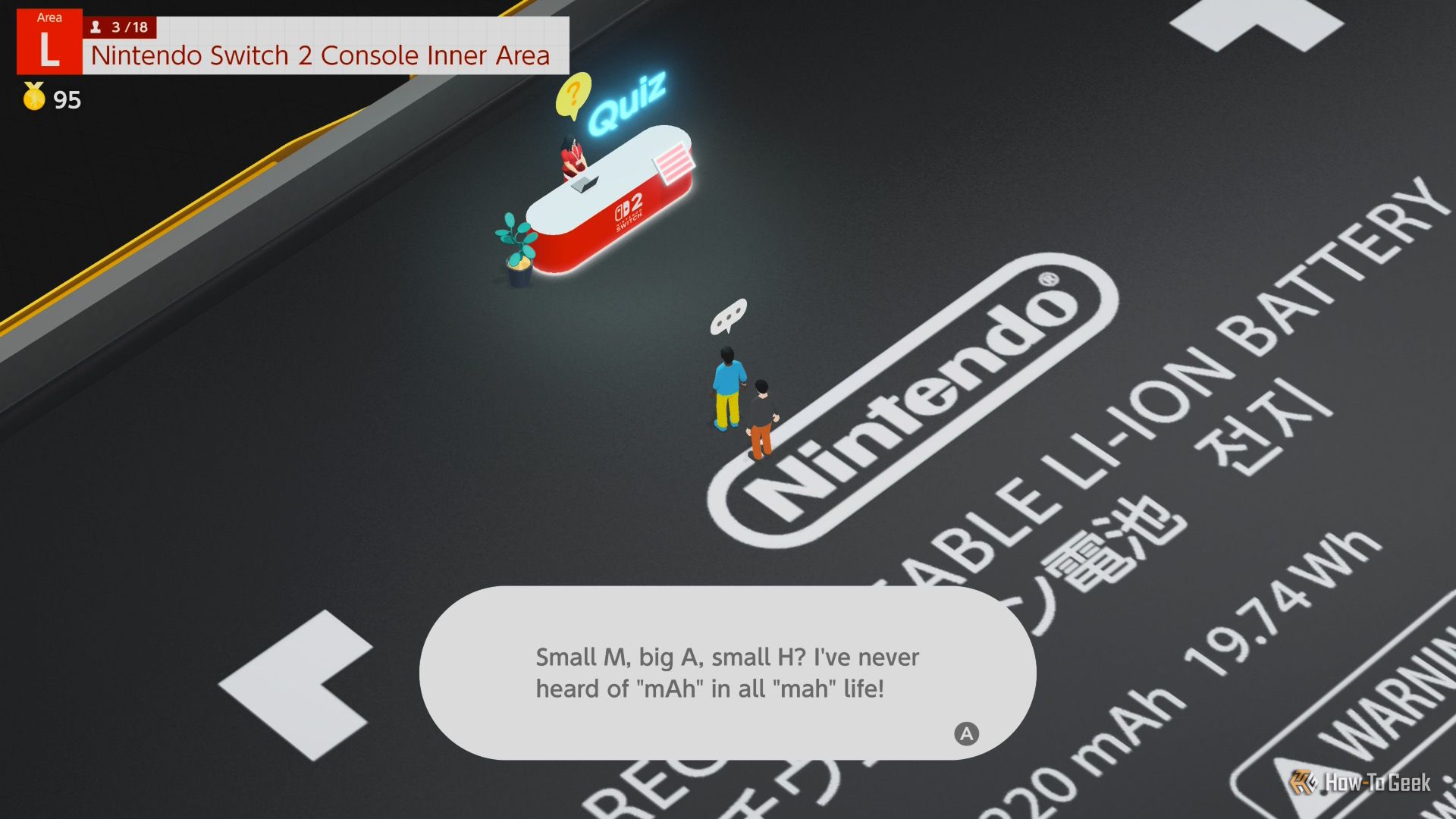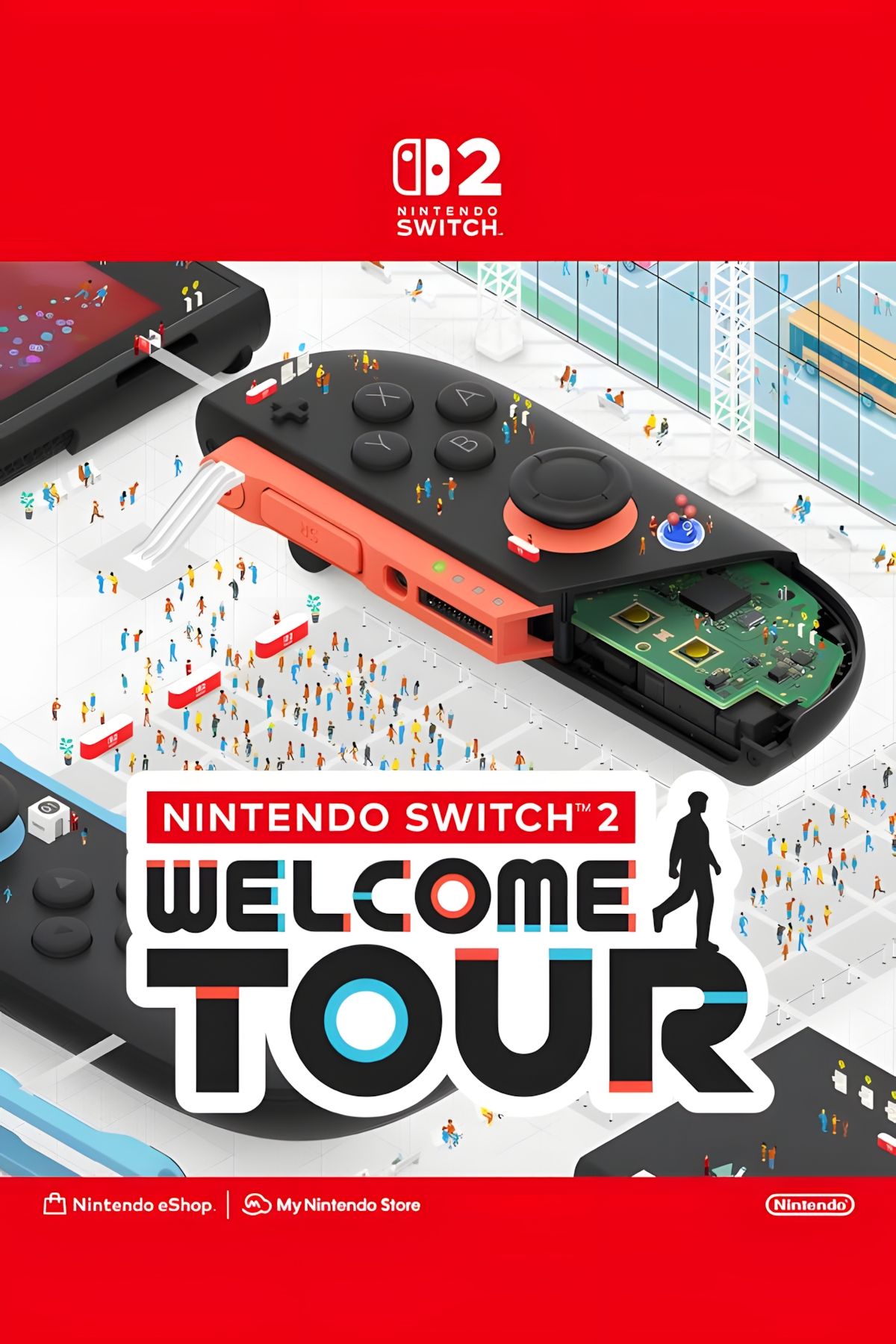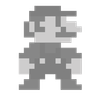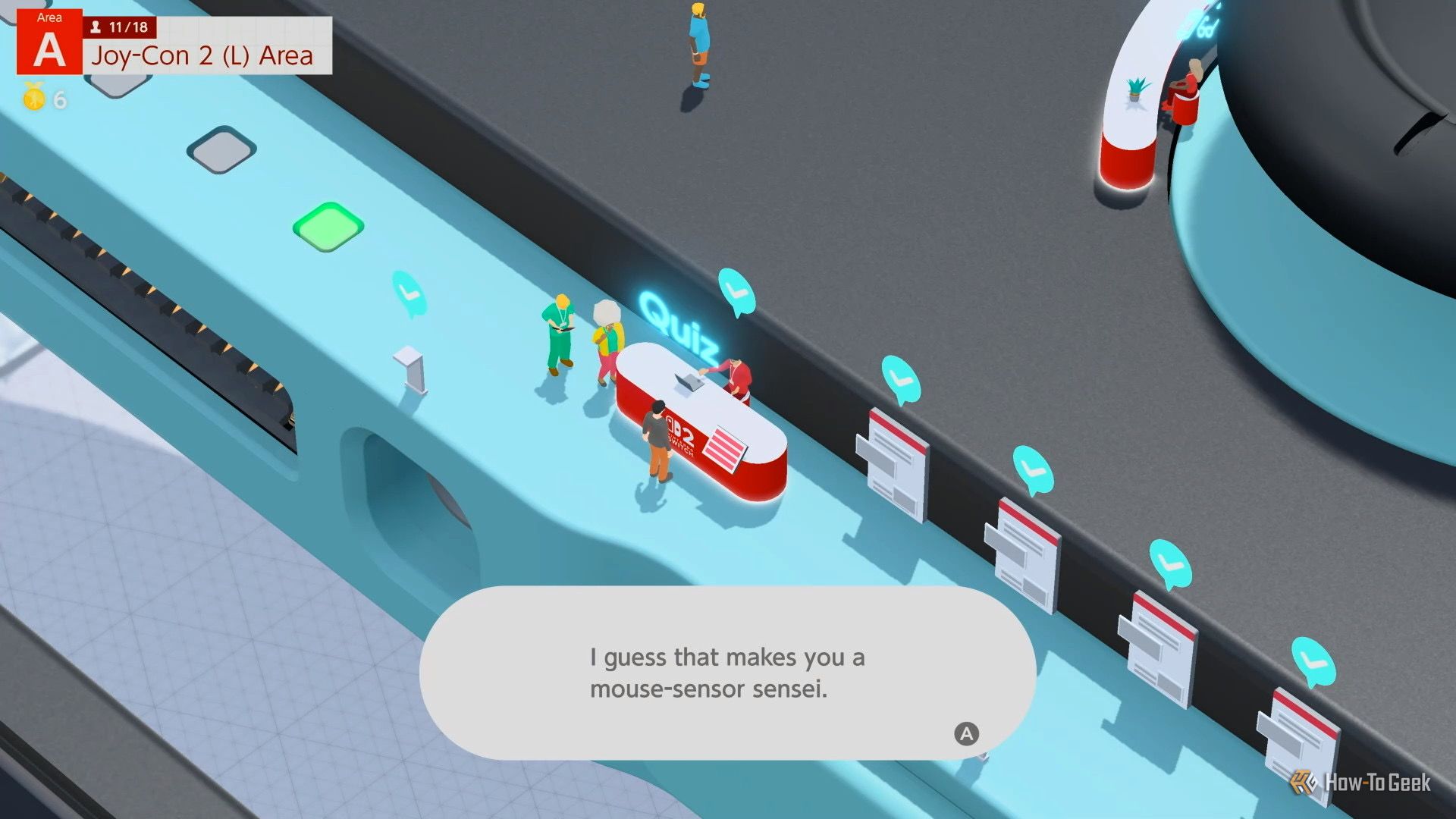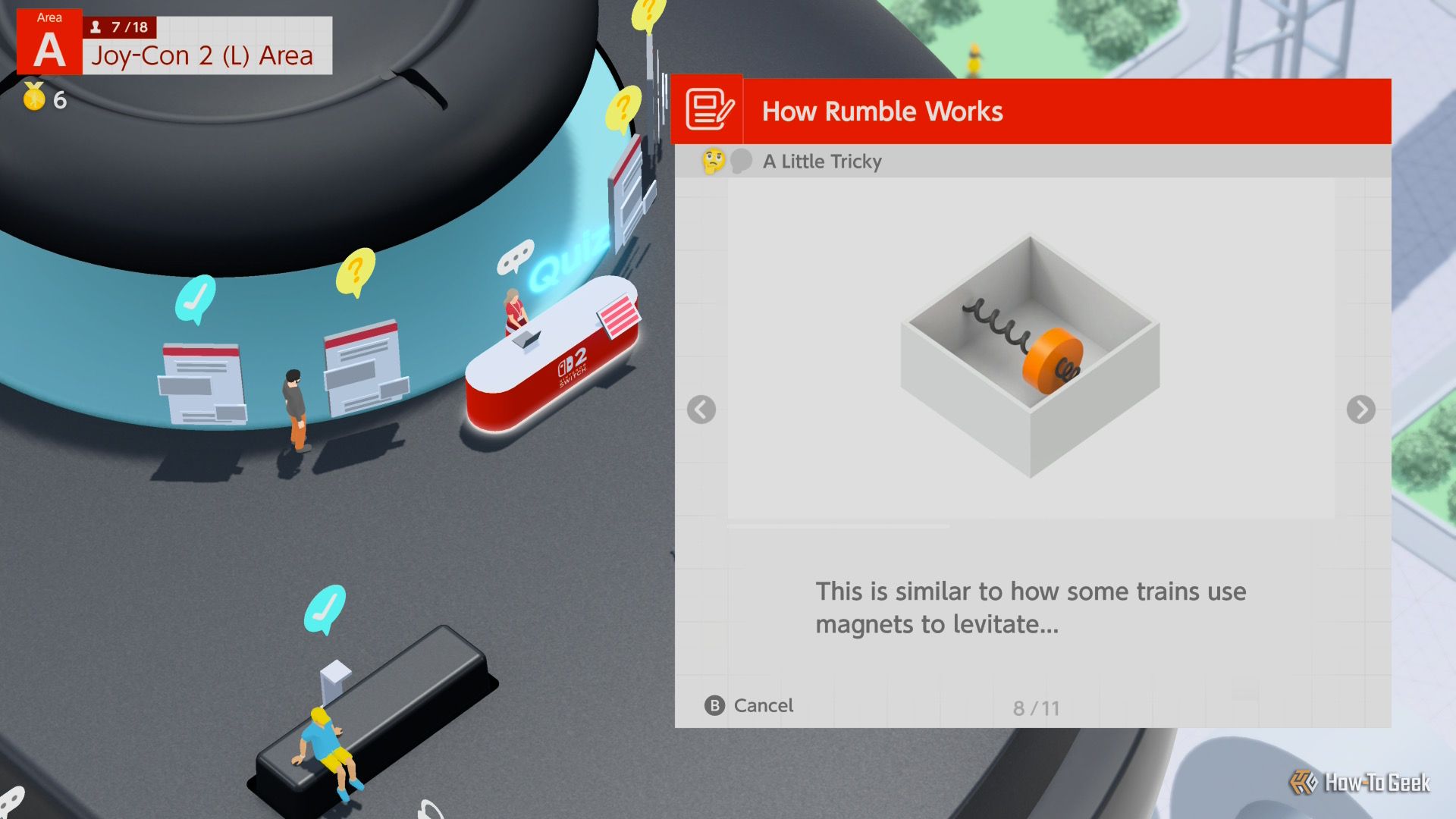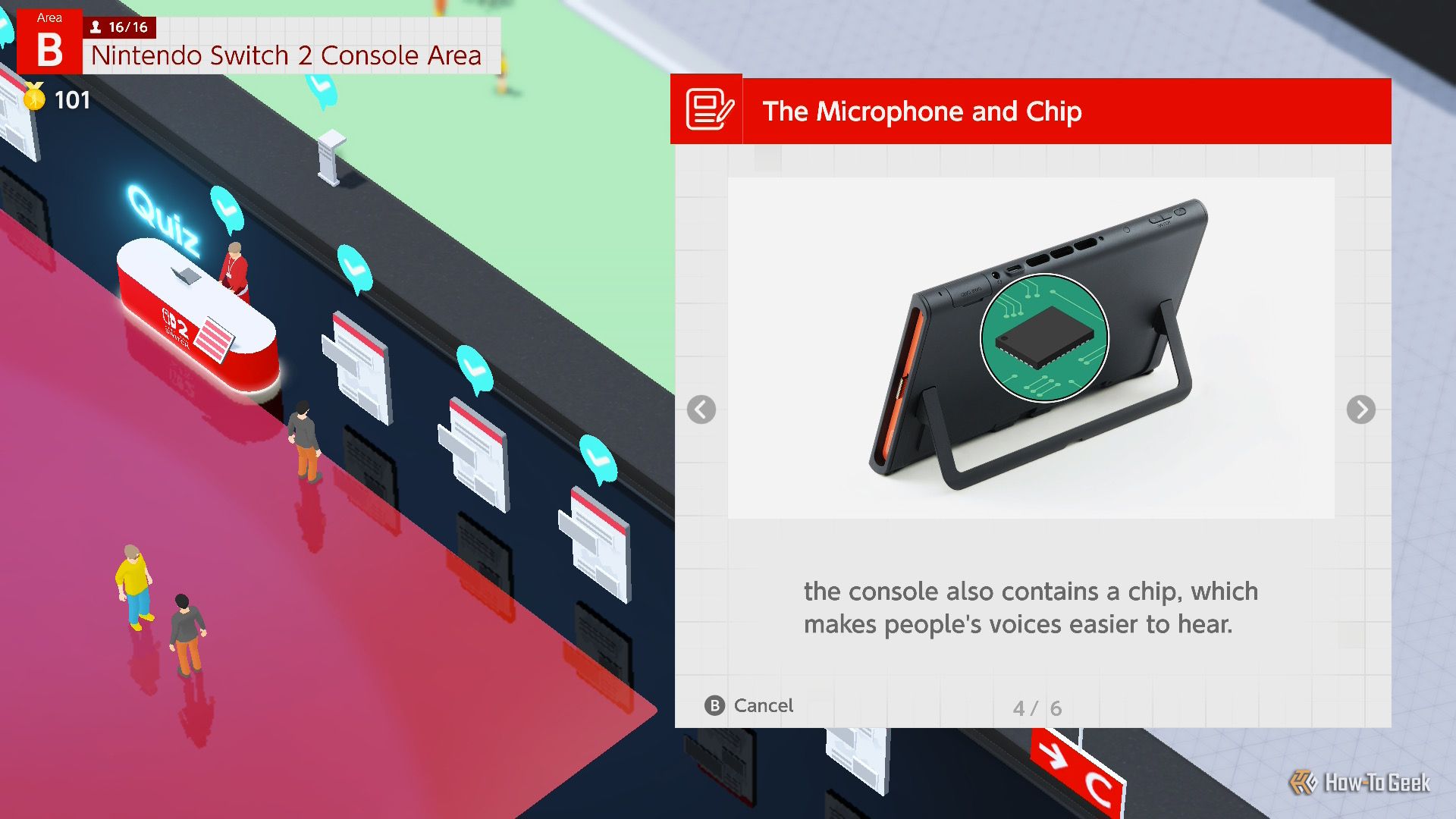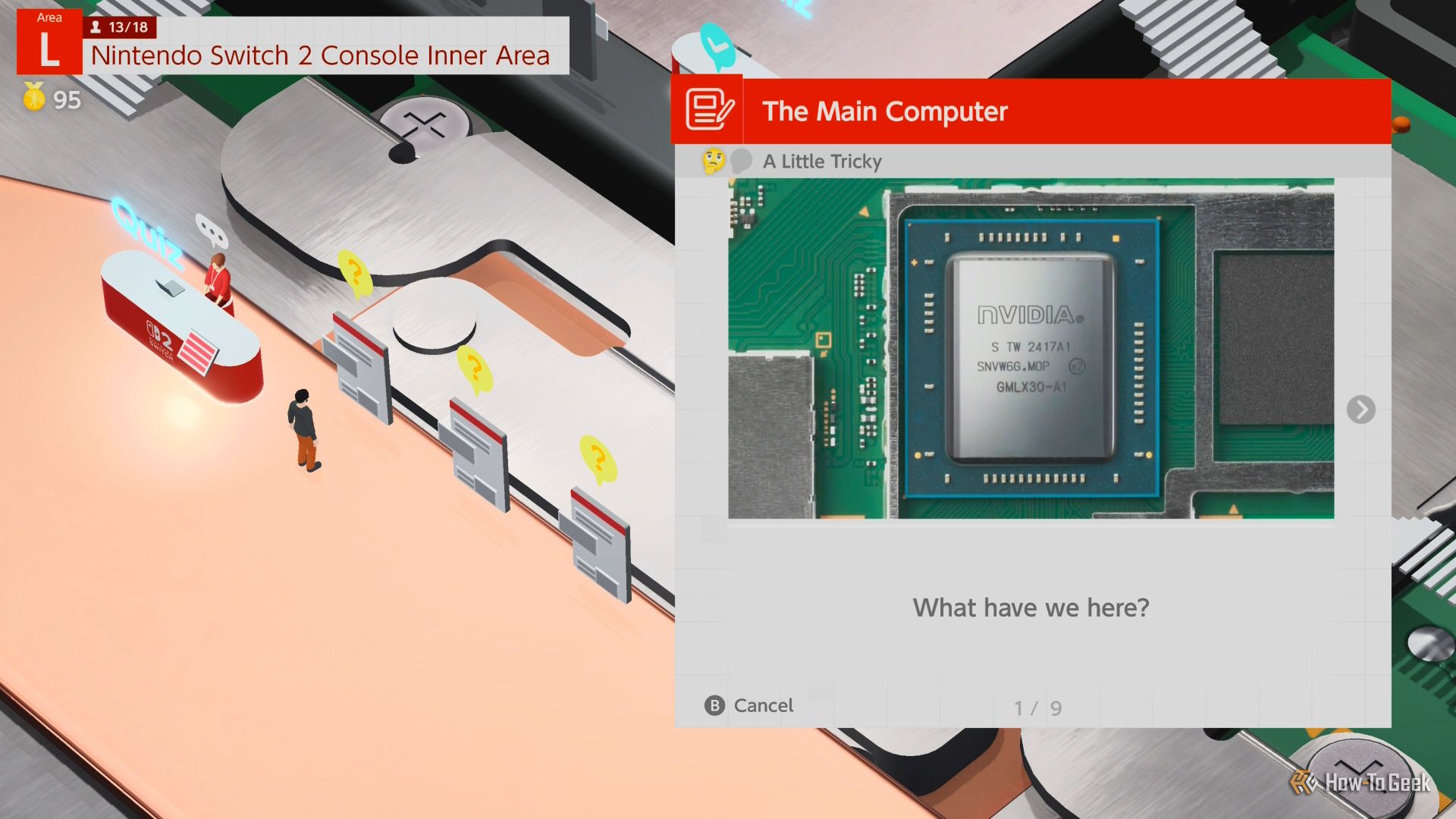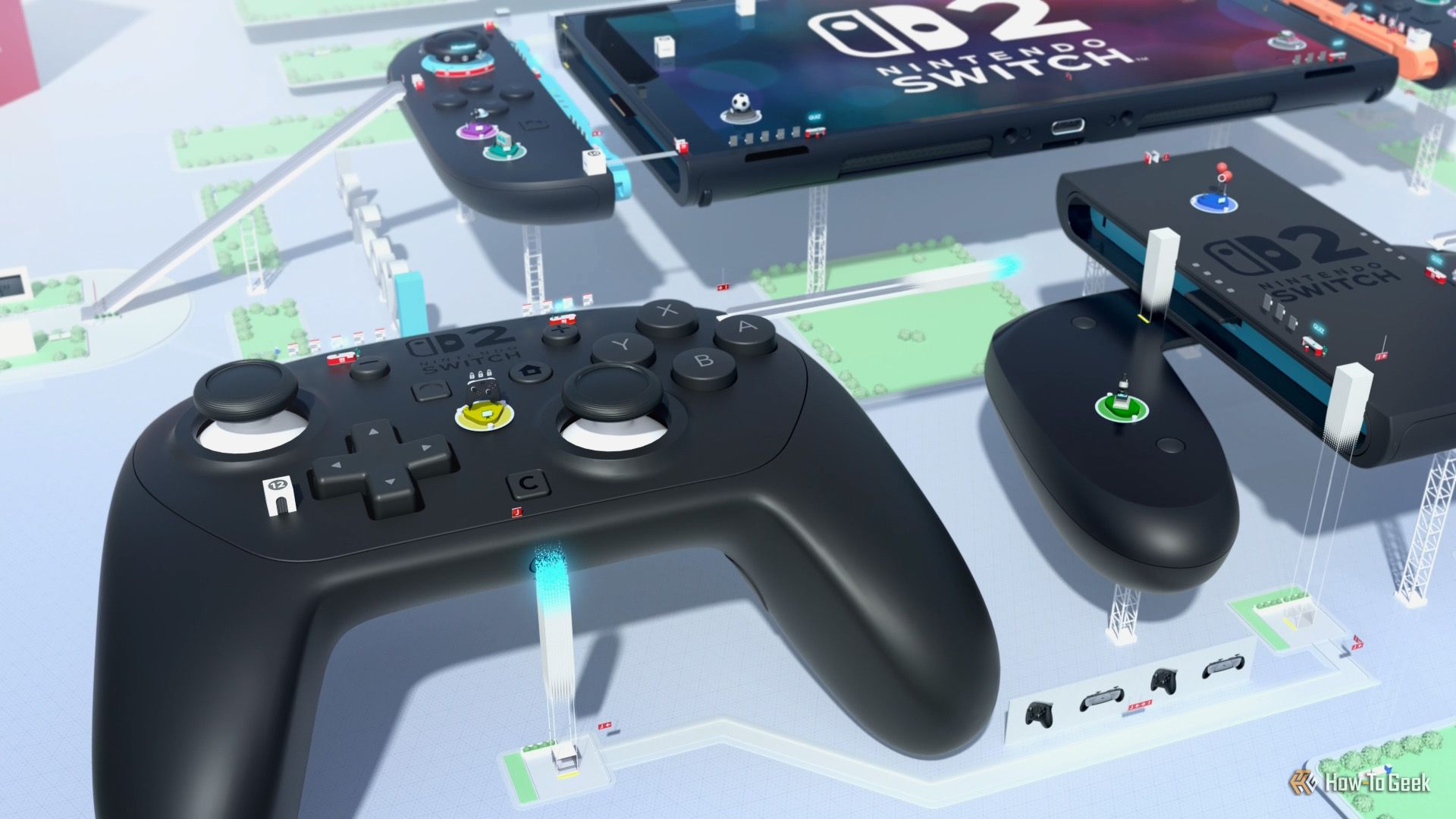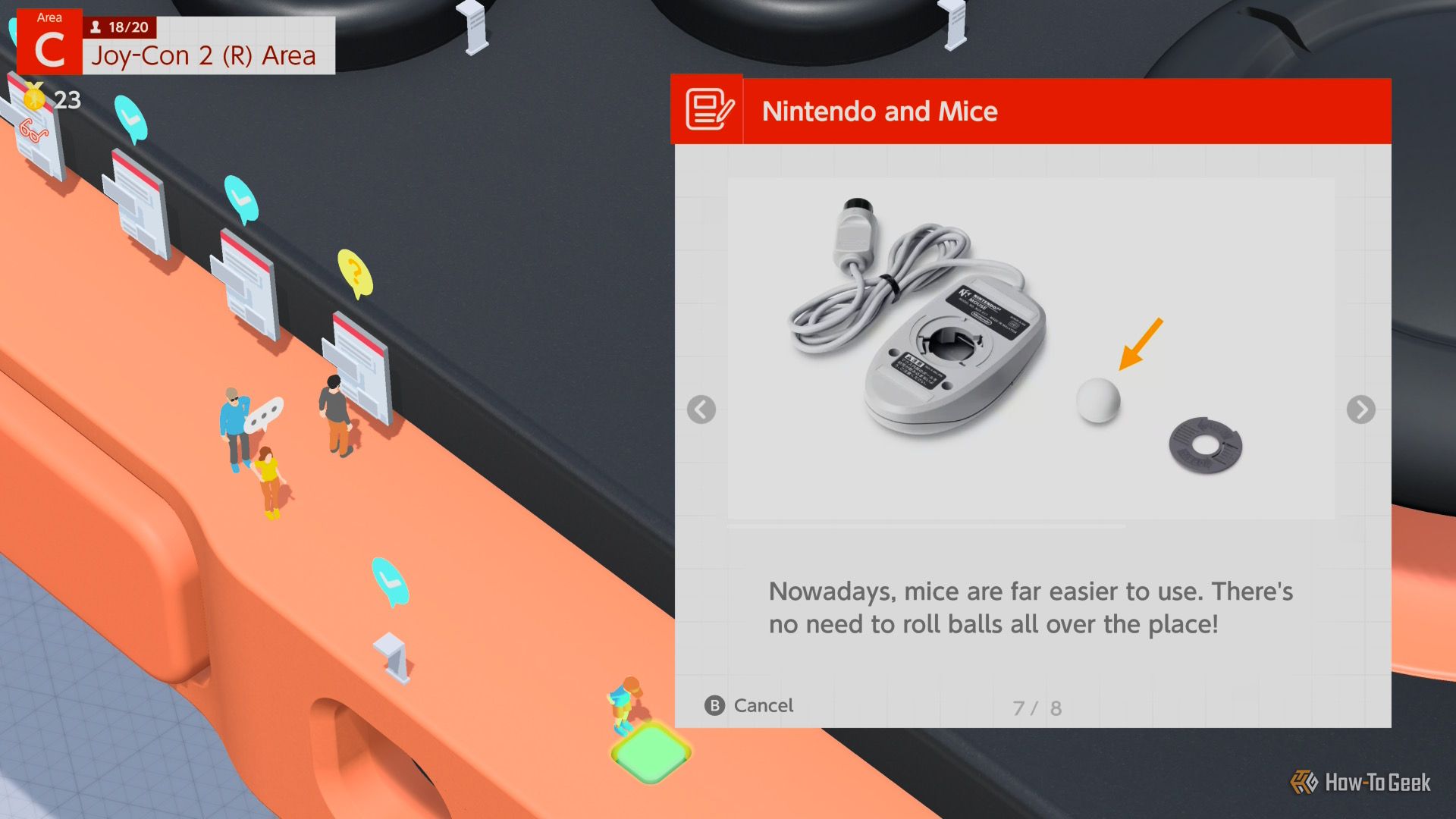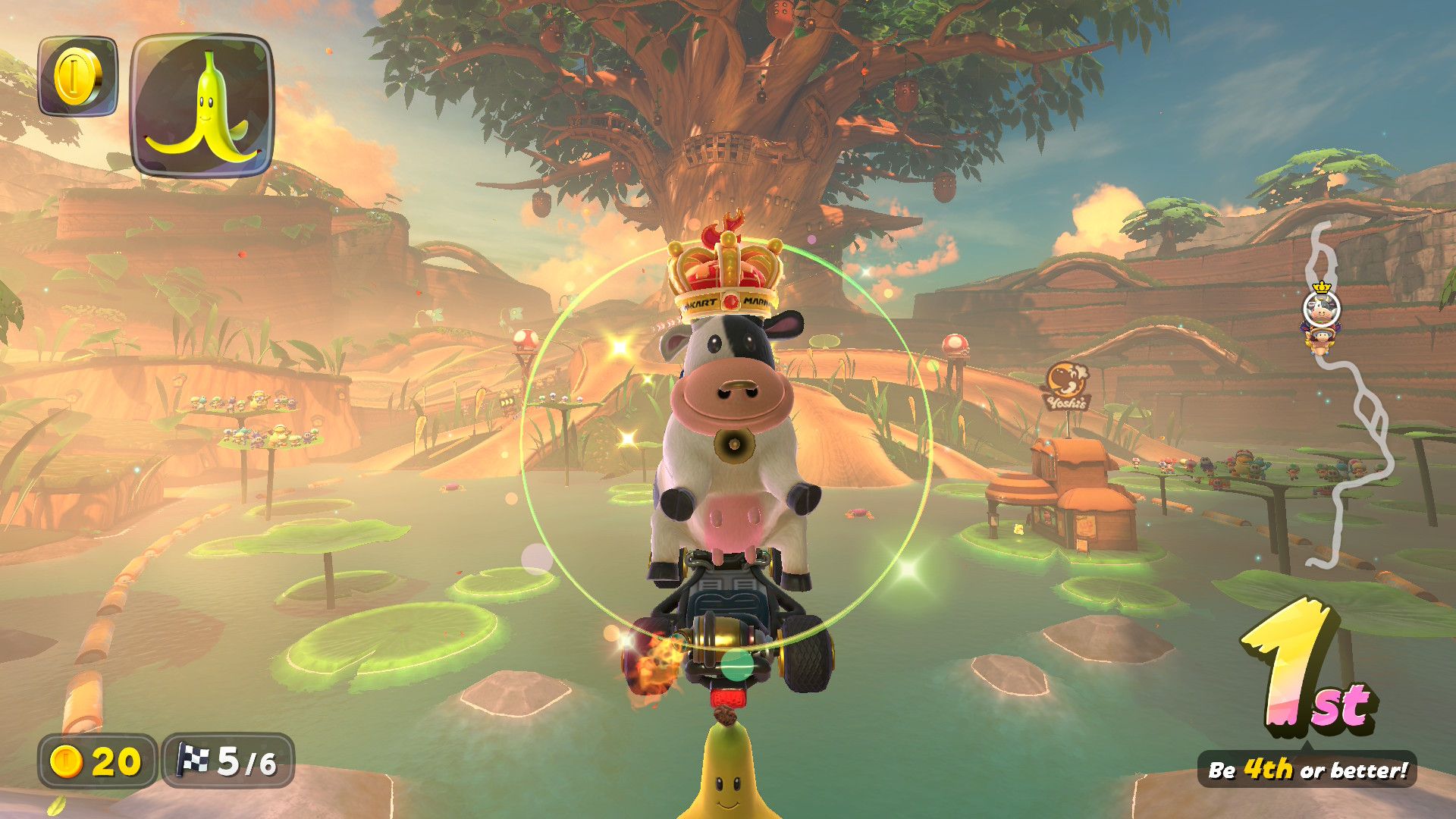It’s hard to excuse the $10 cost of entry for the Switch 2’s glorified Welcome Tour tutorial. However, beyond that price barrier is a font of knowledge geared specifically for tech nerds like us. If you don’t want to pay, I’ve got you covered with the insight highlights.
Welcome Tour Is Great (For the Right Person)
I don’t think the average Switch 2 owner would care much for Nintendo Switch 2 Welcome Tour even if it came pre-installed on every system. The mini-games are hit-or-miss and mostly serve to showcase the possibilities of the Joy-Con 2’s mouse mode, and the tech demos—while often a bit more substantive—are a bit lacking in breadth. While I like demonstrations of VRR, HDR, and refresh rates, there’s not much mass appeal there.
The same can be said about what truly makes Welcome Tour appealing. If you aren’t a tech fan, Nintendo’s deep dive into every technical aspect of the Switch 2 and its peripherals through an expansive series of educational slideshows will quickly have you reaching for your home button. But if you’re curious about every subtle detail of how the Joy-Con 2 magnets work or the circuitry of the console’s motherboard, Welcome Tour is likely to fascinate you. It’s borderline shocking just how open Nintendo is about its engineering secrets, yet I walked away with a far greater appreciation for my Switch 2 because of it.
The fun of Nintendo Switch 2 Welcome Tour is the process of discovery, something deeply undermined by all the facts I lay out here. If you have any plans on picking it up, consider not reading further.
The Engineering Marvels of the Joy-Con 2
Welcome Tour often feels like a chance for Nintendo to showboat how it designed around the Switch 2’s potential problem points, but it’s well-earned given how clever many solutions are.
A series of smart design choices prevent the Joy-Con 2’s magnets from damaging the system. For one, the shoulder buttons on each Joy-Con 2 which house its magnets slightly pop out to hug the magnets hidden behind the color-coded .2 mm film on either side of the system. The looseness of the buttons is to their benefit as it allows the controllers to be jostled without detaching.
This is aided by the slight gap left between the docked Joy-Con 2 and the console, which uses the principle of leverage to stop the controllers from dislodging. In other words, if the edge of the Joy-Con 2 was flush with the console, the edges of each would form a lever that would facilitate the controllers folding over. This isn’t something the Switch needed to consider given its rail-based docking system.
When the Switch 2 was revealed, many people remarked on how the Joy-Con 2 connectors (the thin pieces of metal jutting out of the docks) looked like they could easily snap off. However, Nintendo had the foresight to design around this. The connector and its socket in the Joy-Con 2 are an intentionally loose fit, so even in an unusual scenario when the controllers themselves become loose, there’s enough slack that the connectors won’t be damaged.
Here’s an unrelated problem I hadn’t even considered: the optical sensors that enable the Joy-Con 2’s mouse mode necessitates a key difference from those in your typical mouse. Whereas most mice customize the focus of the optical sensor to fit a single mold, Nintendo needed to account for the heights of the Joy-Con 2 with and without their straps. This required a custom lens, though there isn’t any clarification on the specifics here (Nintendo has to keep some trade secrets to itself, after all).
There are plenty of other juicy Joy-Con 2 details throughout Welcome Tour. While the new controllers look like the original Switch Joy-Con plussed up, small tweaks to every aspect of their design were required to keep them ergonomic for all hand sizes. My favorite detail is how the L and R shoulder buttons were elongated so that they could be easily pressed in mouse mode. In order to retain a tactile feel from all angles, Nintendo added a second shaft closer to the edge of the button.
Audio Trickery Galore
Welcome Tour is eager the ways in which nearly every component has improved from the original Switch. This makes the exceptions stand out, like how the speakers in the Switch 2 are identical to those in the Switch OLED Model. The real story is rather how they designed the casing of the speakers to improve the sound quality.
The Switch 2’s speakers are encased in a tight box with a small opening for sound to escape. This box is surrounded by cushions that prevent sound vibrations from rattling the speaker inside, ensuring accurate audio. Also, while the sound emitted by the speakers is technically directed downward, software editing makes it appear to the player as if it’s being directed straight at them. Similar software tweaking allows the console speakers to give the effect of 3D sound.
Nintendo also spills a lot of ink on the microphone chip dedicated to balancing voice levels and canceling out unwanted sounds. I was impressed during tech demos by just how well it was able to pick up my voice from eight feet away (my couch), even with the AC and a fan on. It’s pretty clear that Nintendo put a lot of its resources into making GameChat a seamless experience, so hopefully the feature manages to overcome its potential setbacks.
Surprising Technical Nitty-Gritty
Welcome Tour’s final area sees you enter the internals of the Switch 2, and the more complex computing topics discussed therein are a feast for tech geeks (like us!).
One highlight I loved was the explanation of how the Switch 2 uses a form of water cooling to counteract the heat from the NVIDIA Tegra SoC (the system’s computing chip). When docked, this is backed up by air cooling in the new dock. There’s also a detailed demonstration of the console’s airflow, including how it equally moves across both sides of the circuit board upon intake. Even with all this, the Switch 2 still runs pretty hot when docked, so there’s a fine line being walked here.
I was also amused by how Nintendo tried to get ahead of the discourse on the LCD screen and battery life. It’s made clear that 1.2x the battery capacity doesn’t mean 1.2x the battery life, though perhaps Nintendo needed an even larger battery given how little uptime the Switch 2 has when undocked. Meanwhile, while the vividness and contrast of the previous Switch’s OLED screen was noted to be greater, Nintendo was sure to tout the new LCD panel’s higher brightness, HDR and VRR capabilities, and 120 Hz refresh rate. Oh, and how big it is. It’s very big.
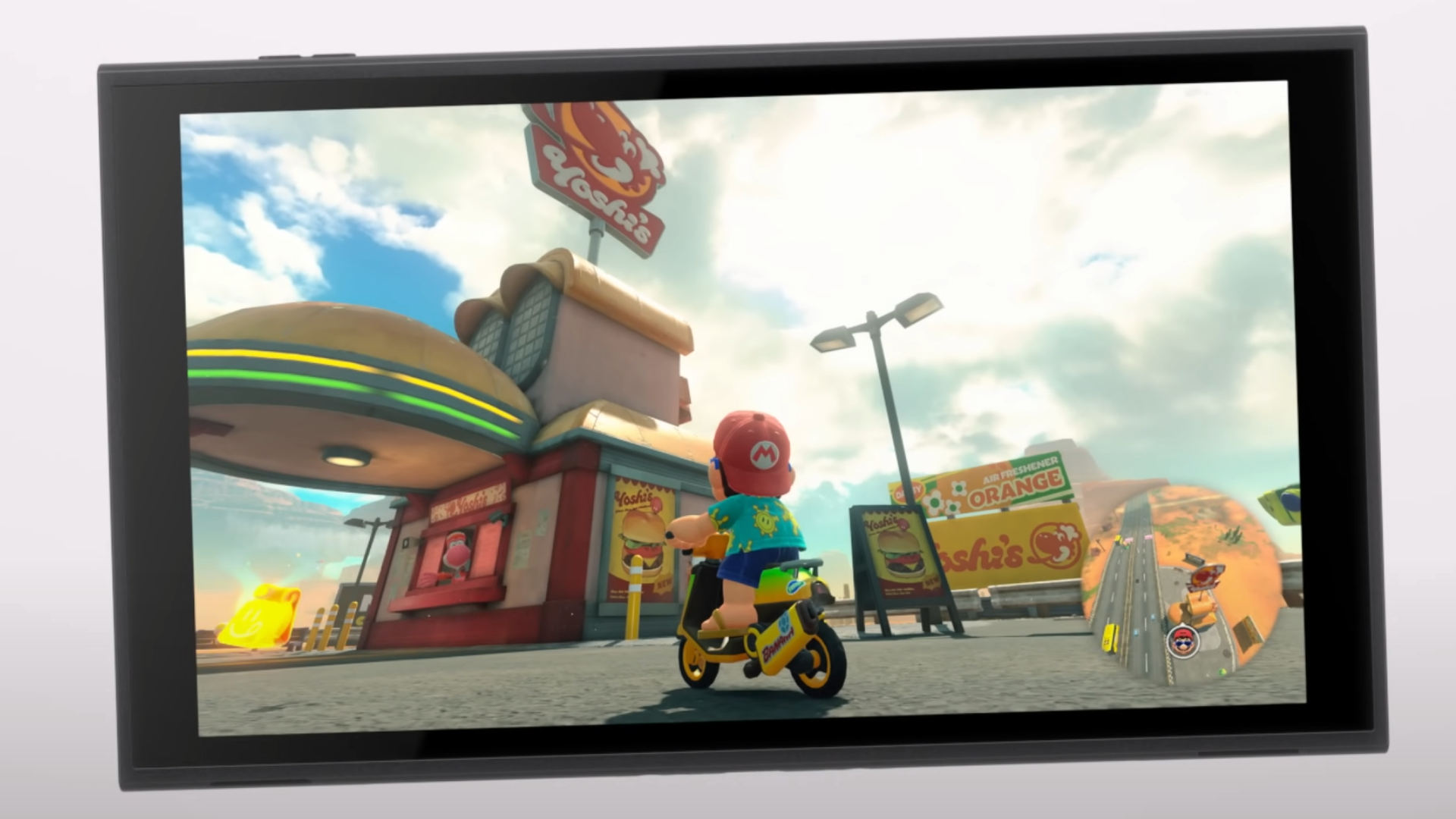
Related
Nintendo also goes into detail on memory transfer, circuitry, and more. If this is your wheelhouse, it’s probably worth picking up the game to not only discover this yourself but take a digitized look at the digital layout of every component.
Odds and Ends
There’s a potpourri of small factoids littered throughout Welcome Tour that come out both in explainers, tech demos, and mini-games.
Perhaps my favorite of these is how an extra bit of plastic was added to one rubber foot of the Switch 2 dock in order to stop it from toppling over if a cable is tugged. This was an issue I had with previous Switch docks but never even considered Nintendo would address, yet it’s exactly this attention to detail that makes the Switch 2 so impressive.
The full suite of Switch 2 launch peripherals is on display during the tour, and while most of them see Nintendo attempting a hard sell where it’s not warranted, the Switch 2 Pro Controller is an exception. The tweaks it makes to the original Switch Pro Controller design are greater than they appear at a glance, with the most interesting bit of trivia being how the thinner handles were inspired by the GameCube controller. However, the most impressive showcase is how the “soft-gliding sticks” work, using a ring of soft material at the base of the sticks to prevent it from ever reaching a hard stop. This creates a gliding sensation that I’ve personally found sublime when using the Switch 2 Pro Controller myself.
For all the answers it provides, Welcome Tour also creates a few new questions. For example, a mini-game where you adjust the Switch 2’s stand to match a stated angle with measurements down to a precise degree left me befuddled. It doesn’t use the Joy-Con 2, so gyroscopes and accelerometers are out of the question. Is there a sensor in the stand? If so, why? Maybe that’ll be in the much-anticipated Welcome Tour sequel. (Ha.)
There’s More Where This Came From
If this highlight reel was an interesting read, I recommend taking the $10 plunge and giving Nintendo Switch 2 Welcome Tour a look for yourself. There’s plenty I didn’t cover here, especially when it comes to easily parsed explanations of computing terms and systems. Plus, the quizzes have a great sense of humor to them, elevating what’s essentially edutainment to a chuckle fest. Nintendo Treehouse had a field day with this one.
I hope the idiosyncratic, small-scope spirit of Welcome Tour is a sign that the Switch 2 will be an experimental era for Nintendo. With the cost of major releases increasing, smaller experiences with niche appeal would act as a counterbalance. If there’s anything that could come from this not being a pack-in, it’s convincing Nintendo that there’s an audience who want more than just the tentpoles. Unfortunately, it might be the wrong messenger for the right message.
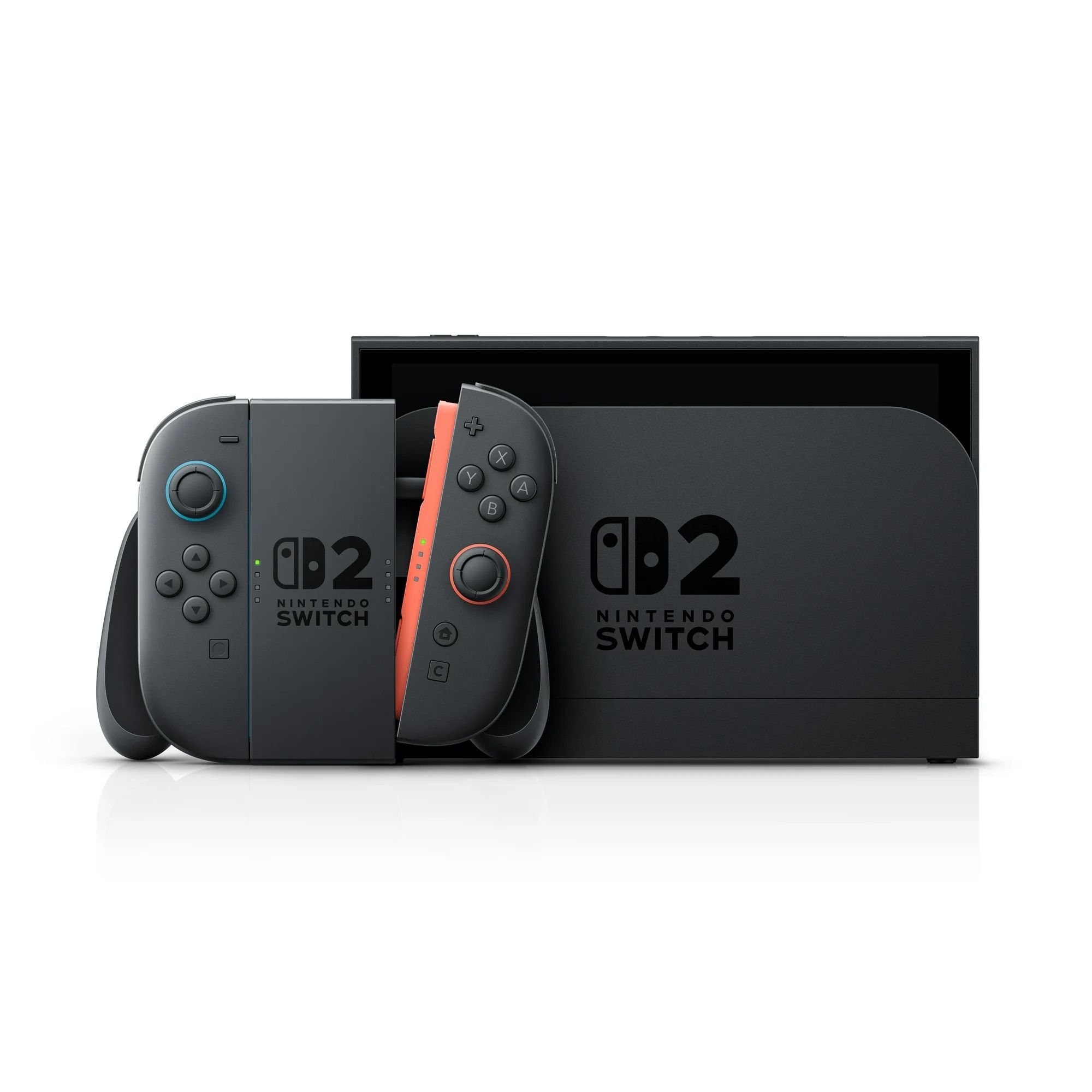
- 4K Capability
-
Yes
- Brand
-
Nintendo
The Nintendo Switch 2 is the company’s latest hybrid home console, with more powerful graphics and processing, a larger 7.9” LCD touch screen with support for HDR, and more online features.
